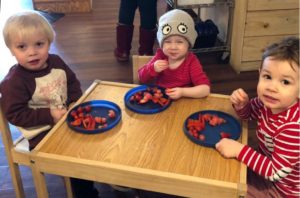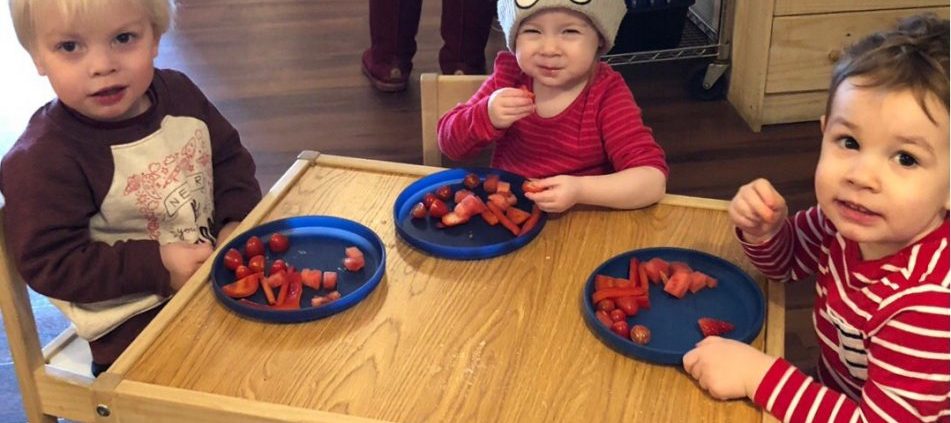When your kiddos are at home, lunch can take a variety of forms. From picnics outside to eating at the kitchen table or in the living room, lunch is a great opportunity for our children to begin winding down before an afternoon nap. Often times you will notice at daycares and schools the youngest are strapped into high chairs for the first couple years of their life to minimize spilling and create efficiency for adults during meals. In Montessori schools, however, we believe meals provide a communal time to gather, learn manners and practice conversation skills. More than that, meals should offer beauty for diners, even if those diners are only 1 year old!

 Starting in our infant room we give our youngest the ability to eat independently as soon as possible. From learning to hold their own bottle, to using a spoon and feeding themselves, it is important to allow them independence whenever possible in a world that they are often so dependent on. In addition to this, our infant teachers encourage sign language from the moment the child enters the room so they can ask for more food, learn manners and tell their teachers when they are finished eating, an important skill to learn early on. As soon as the child has mastered the art of sitting on their own and their teachers feel that they will be safe in their own chair, often around 12 months old, the child will move from a highchair to a low seat at a table which they can access on their own. This gives them an added level of independence because they can more easily tell their guides when they are done eating and they are no longer dependent on an adult to get to their table. It is at this point that they are almost ready to move onto the toddler room!
Starting in our infant room we give our youngest the ability to eat independently as soon as possible. From learning to hold their own bottle, to using a spoon and feeding themselves, it is important to allow them independence whenever possible in a world that they are often so dependent on. In addition to this, our infant teachers encourage sign language from the moment the child enters the room so they can ask for more food, learn manners and tell their teachers when they are finished eating, an important skill to learn early on. As soon as the child has mastered the art of sitting on their own and their teachers feel that they will be safe in their own chair, often around 12 months old, the child will move from a highchair to a low seat at a table which they can access on their own. This gives them an added level of independence because they can more easily tell their guides when they are done eating and they are no longer dependent on an adult to get to their table. It is at this point that they are almost ready to move onto the toddler room!
 If you have ever raised a toddler, you know how difficult meal time can be. From picky eaters to throwing food, the list of fun activities a toddler discovers while eating seems never ending. But enter a Montessori room during lunch time and you will be amazed at the serenity that is often present during the meal. All toddlers are seated independently at low tables or slightly larger tables depending on their height. The tables are draped with beautiful table cloths and they are served meals they can eat independently. Once all children are seated, they wait to eat until they say their wish together in English, Spanish, Portuguese, Sign Language or a combination of the above depending on the classroom.
If you have ever raised a toddler, you know how difficult meal time can be. From picky eaters to throwing food, the list of fun activities a toddler discovers while eating seems never ending. But enter a Montessori room during lunch time and you will be amazed at the serenity that is often present during the meal. All toddlers are seated independently at low tables or slightly larger tables depending on their height. The tables are draped with beautiful table cloths and they are served meals they can eat independently. Once all children are seated, they wait to eat until they say their wish together in English, Spanish, Portuguese, Sign Language or a combination of the above depending on the classroom.
“We wish for peace, food, and happiness, for all the children of the world.”
Once the wish is complete, the children can begin eating. Depending on their verbal skills, the child can ask for more milk or food through sign language or newly acquired words. When they are done eating, they get up from the table with their plate, head to the garbage and scrape the extra food into the pail before setting their plate in an easily accessible bucket for dirty dishes. The children then head to the bathroom to wash up before nap. If they spill? They are not scolded or made to feel bad, they are still learning! Instead the child is offered a towel to clean up their mess, often aided by a friend close by who wants to help. Understanding a child’s need for independence at an early age is critical for helping your child be as successful and happy as possible. Anywhere from 31 to 36 months old, the child is ready to move up to Children’s House, the preschool rooms that have children ranging in age from 2.5 years old to 6 years old.
 In Children’s House, independence is taken one step further as the children are responsible for helping set up and clean up their lunch environment. The tables have table cloths and at this age, the children are capable of using real plates, silverware and cups. Because of Montessori’s belief that children deserve to be surrounded by beauty, these are often ceramic or china plates. The children also set their communal tables with small pitchers for milk and they may choose to decorate their tables with small vases of fresh flowers that were arranged by classmates earlier in the day. Everything is methodically chosen to be easily manipulated by small hands. Once dismissed for lunch, the children are free to sit wherever they like where they then wait to say the wish before lunch. Because of the age differences in the classroom, the freedom to choose their seating arrangements each day leads to the youngest children in the class learning manners from their older classmates while the oldest get the opportunity to act as role models. During this 30 minute period of time the children learn how to pour from a pitcher to a glass, clean up spills, hold conversation, chew with their mouths shut, politely ask friends to “please pass the milk pitcher,” and eventually how to dismiss themselves when they are done eating, clean their plates off and head to the bathroom. Non-nappers are also part of the clean-up process which includes sweeping, cleaning tables and preparing laundry. This allows the children to feel a sense of responsibility about keeping their space clean and feeling proud of the work they do.
In Children’s House, independence is taken one step further as the children are responsible for helping set up and clean up their lunch environment. The tables have table cloths and at this age, the children are capable of using real plates, silverware and cups. Because of Montessori’s belief that children deserve to be surrounded by beauty, these are often ceramic or china plates. The children also set their communal tables with small pitchers for milk and they may choose to decorate their tables with small vases of fresh flowers that were arranged by classmates earlier in the day. Everything is methodically chosen to be easily manipulated by small hands. Once dismissed for lunch, the children are free to sit wherever they like where they then wait to say the wish before lunch. Because of the age differences in the classroom, the freedom to choose their seating arrangements each day leads to the youngest children in the class learning manners from their older classmates while the oldest get the opportunity to act as role models. During this 30 minute period of time the children learn how to pour from a pitcher to a glass, clean up spills, hold conversation, chew with their mouths shut, politely ask friends to “please pass the milk pitcher,” and eventually how to dismiss themselves when they are done eating, clean their plates off and head to the bathroom. Non-nappers are also part of the clean-up process which includes sweeping, cleaning tables and preparing laundry. This allows the children to feel a sense of responsibility about keeping their space clean and feeling proud of the work they do.
So there you have it. A glimpse into what a Montessori lunch looks like. Does it always end up a serene and peaceful lunch? No. Is there milk spilt and plates broken on a daily basis? Absolutely. But the beauty of being a child is that in order to learn, you must make mistakes and be encouraged to try again, and lunch time at PVMA offers that opportunity every day of the week. Bon appetite!
If you are interested in finding a daycare or preschool for your child and want to learn more about us, please don’t hesitate to reach out! We are happy to answer questions about our infant, toddler, preschool and kindergarten programs or set up a time for you to take a tour.




Leave a Reply
Want to join the discussion?Feel free to contribute!